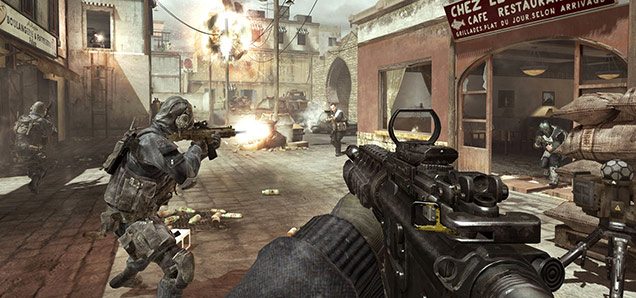G33K LYFE: Narrative in FPS: The Modern Warfare trilogy
 CREDIT: INFINITY WARD
CREDIT: INFINITY WARDThe narrative in first person shooter game trilogy Modern Warfare causes gamers to question their actions.
SPOILER WARNING: This article contains spoilers for the Call of Duty series.
There is no singular genre that defines the video game industry – no more than film is only drama or music solely consists of hip-hop, but at any point in time, an outside observer could have a look in and think that there was. If that outsider was to look into the gaming world during the majority of the last decade, they would think the defining genre was military shooters, for one simple reason, they were everywhere.
The saturation of the military shooter into the mainstream gaming channels saw the release of titles varying in quality to the utterly terrible to the utterly sublime, as shooters helped propel online competitive gaming to the level it is at today. With the majority of these titles focusing heavily on gameplay and multiplayer rewards, the single player campaign, once the bread and butter of every video game released, fell to the wayside and were replaced by cookie cutter characters who spoke in pure jargon and ooze the hoorah spirit of the most obvious military propaganda.
However, at the very peak of military shooter pile between 2007 and 2011, was Call of Duty’s Modern Warfare trilogy, a chillingly effective look at a series of “what if” scenarios that result in a third world war, a drastic change from the traditional shooter settings of World War II. Across three games, players witness and fight through the early days of a struggle that sounds not unlike what we’ve been hearing in the news the past several months, a coup in the Middle East and a civil war brewing in Russia (three missions set in Ukraine).
As the story progresses, the war escalates and takes several shocking (if somewhat unrealistic) twists and turns along the way, as it turns out the global conflict came down to the machinations of one man, who was in turn hunted down by a singular rival, but then it’s the stop made along the way that made the trilogy so revolutionary for its time, and such a significant entry in the shooter genre.
The first moment that comes to mind is during the Middle Eastern portion of the first game, where the player character boards a helicopter, only to witness a nuclear explosion in the distance, which takes down his, and many other helicopters.
While most gamers would have expected for it to be done there, they were instead treated to a mini-mission where they crawled out of the wrecked helicopter into a nuclear wasteland, take a single step, and perish. It was the first time I recalled playing through my own characters death, and boy was is effective. It was Modern Warfare 2 though, where the story really began to catch my eye, especially the missions taking place during the Russian invasion of the U.S.A.
Perhaps it was the sudden exchange of battlefields, spending a game and a half waging war in the usual setting of fields and Middle Eastern towns to suddenly be fighting through a suburban neighborhood like so many that we’ve all seen before. The image of a Russian vehicle indiscriminately blowing up houses is a rather chilling image, and reminiscent of what it would be like if our society were to suddenly fall victim to a surprise invasion, almost like playing through the beginning of Red Dawn (the Swayze version, not the terrible remake) and it’s all too close to home.
Of course no discussion of the trilogy would be complete with touching upon the infamous “No Russian” mission in Modern Warfare 2, the mission in which the player, taking control of an undercover CIA operative in a terror cell as they conduct the massacre of hundreds of civilians in an airport. Yes the actions being portrayed on screen, are atrocious, but it’s the small details of the level that make it all the more disturbing.
I hadn’t touched the mission in three years, and when I sat down to refresh myself as to how it went I found myself noticing things I hadn’t the first time through, I noticed that my movement was reduced to a slow, methodical walk, directly behind my co-terrorists, I took note of how the civilians differed from the usual targets in this game, they hid, they surrendered, they attempted to drag the wounded to safety, but it was no matter, all of them were doomed and there was nothing I could do about it.
And there lies the brilliance of the level design, as it pulls you through this horrific scenario and forces you to comply, sure you can avoid shooting the civilians, or shoot the walls to make it look like you’re trying, but they will die all the same, and eventually, when the fire is returned, you’re forced right back into usual Call of Duty play. Despite the distastefulness, the mission was effective at causing the gamer to question his/her actions, and more importantly, kicked open the door toward storytelling in games, and the limits it would allow.
(Writers note: There is one other FPS title that did important narrative things, it will get its own column soon)













